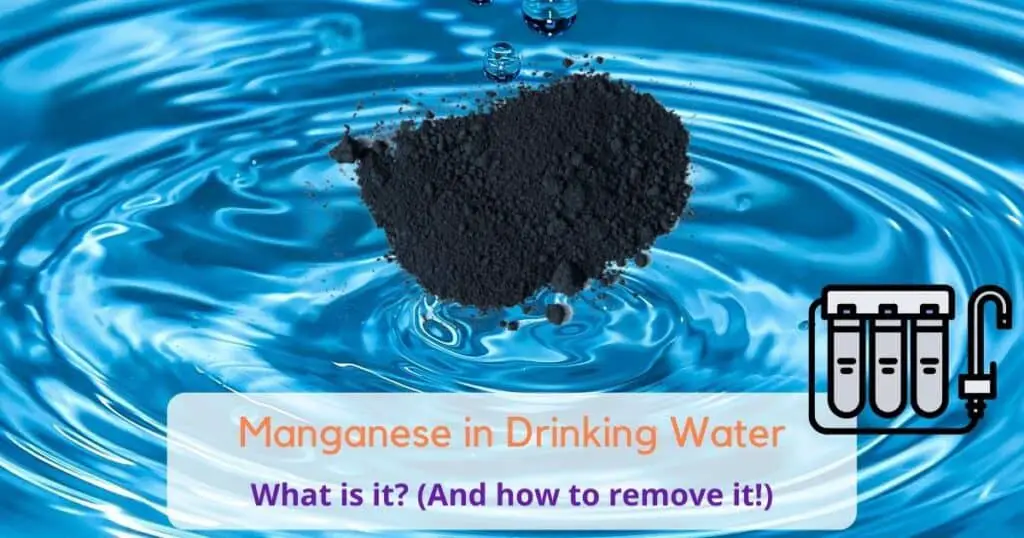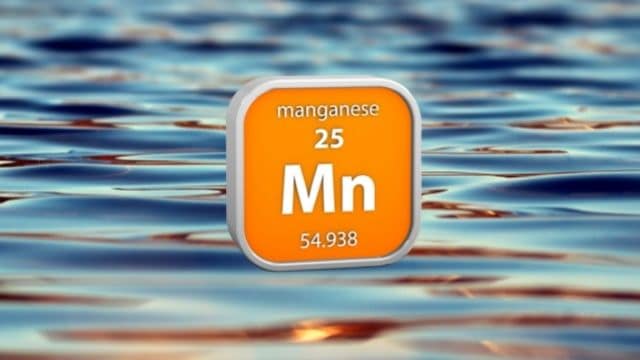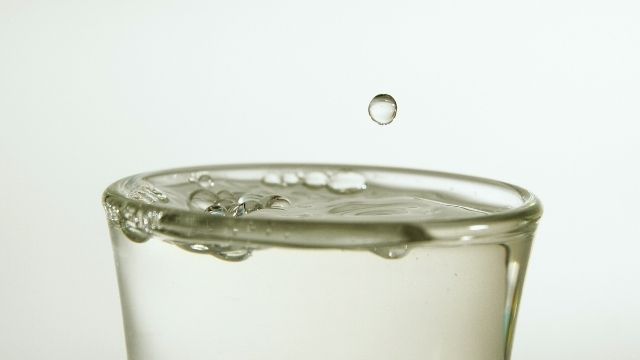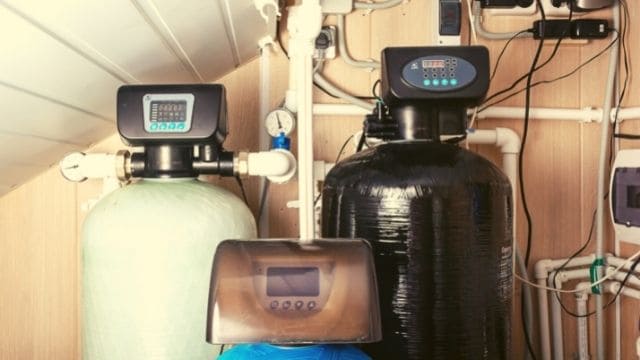
Over the last twelve months, many visitors to this site have contacted me about black stains in their water or even small black particles in their drinking water. For most people, it’s enough to be worried.
Fortunately, one of the most likely explanations is manganese in well water. And there are simple ways to test for and remove it. Take a sigh of relief!
Let’s find out what manganese in drinking water is, how a well water test kit can help, and then look at the best filters for removing it.
What is manganese?
Manganese is a mineral found in soil, water, and air. It is essential to plant life and helps form enzymes necessary for growth. Its chemical element number is 25, and its symbol is Mn [1].
Manganese is an essential nutrient and necessary for human health. It is a component of many enzymes and proteins that help the body function properly.
Functions of manganese in the body include the formation of connective tissue, bones, and sex hormones. It is also required for blood sugar regulation, iron absorption, and proper nervous system function.

How does manganese get into drinking water?
Manganese can get into drinking water from natural sources, such as soils and rocks, or from man-made sources, such as wastewater discharge or mining operations. It’s commonly found in water alongside iron and most commonly found in houses with a private well.
Water from deep wells that have been in touch with rock for longer periods generally contains more natural iron and manganese than water from shallow wells [2].
Benefits of manganese in drinking water
In general, our dietary intake of manganese (i.e., the manganese found in our food) is more than enough to benefit from the health effects of manganese for most people.
So for most people, having a safe level of manganese in their drinking water is unlikely to have much of a positive impact. A balanced, healthy diet is much more effective.
Either way, manganese does have some health benefits [3], such as:
- Aiding digestion
- Increasing bone strength
- Supporting the healing of wounds
- Detoxification
Negatives of manganese in drinking water
Manganese in drinking water is usually only a health concern when present at very high levels. Long-term exposure to manganese in water has been associated with a Parkinson’s-like disease called manganism.
Aesthetic problems like staining and discolored water are more likely to be the main concern for most people.
Let’s look at each point in more detail.
Aesthetic considerations
Aesthetic problems caused by too much manganese in water include staining of clothes, fixtures, and skin; and discoloration of the water itself. Some people report seeing black stuff in their water.
When water has a high manganese concentration, it often looks like black or greenish-black tea.
As high levels of iron often accompany high levels of manganese, the color of the water can also be red, brown, or yellow.

Taste
Manganese can also give water an unpleasant taste or odor. People usually describe the taste as earthy, metallic, or bitter. The smell is similar to that of rotting vegetables.
Is manganese harmful to health in drinking water?
As previously mentioned, manganese does not generally create health concerns for most people.
However, according to the Minnesota Department of Health, long-term exposure to high manganese levels in drinking water can be problematic.
Long-term exposure to manganese can negatively affect
- memory,
- attention,
- and mobility.
Is too much manganese a health risk for children?
When infants (under 12 months old) drink water with elevated manganese levels, they may develop learning, brain development, and behavioral difficulties.
Scientists have found links between magnesium exposure in children and several symptoms:
- lower IQs
- Impaired memory
- Impaired academic skills
- increased risk of ADHD
- behavior problems
- attention problems
Following a 2016 study [4] about excessive manganese levels in infant formula, scientists recommended that U.S. regulators take immediate action to eliminate the use of supplemental manganese. So it’s reasonable to assume that we shouldn’t be taking any chances with manganese in our drinking water either.
Manganism
Manganism is a brain disease caused by long-term exposure to high levels of manganese. It is similar to Parkinson’s disease, and symptoms include:
- Tremors
- Muscle stiffness
- Slow movement
- Weakness
Manganism is a rare condition, and studies [5] link the disease to industrial and occupational exposure to manganese and not to exposure through drinking water.
How much manganese in drinking water is safe?
The US Environmental Protection Agency (EPA) has established an acceptable daily intake level (ADI) for manganese in drinking water of 0.3 mg/L, which is intended to protect the general population from long-term exposure [6].
They also state that the general public should not drink water with manganese levels higher than one mg/L for more than ten days each year.

Manganese limits for infants
The US EPA recommends that infants under six months should only drink water with manganese concentrations greater than 0.3 mg/L for a maximum of 10 days per year. These ten days per year also include days where baby formula is made with manganese-contaminated water. [7]
Secondary manganese guidelines
While not a health concern, low levels of manganese in the water can still result in stained water and complaints about the taste. For this reason, the US EPA has a guideline of 0.05 mg/L to protect people from stained water and poor taste [8].
Testing for manganese
If you notice black stains on your plumbing fixtures, faucets, toilets, showers, or laundry, manganese is likely present in your drinking water. Home Water Research suggests that you have your water tested to determine the amount of manganese present and assess your drinking water quality.
We recommend a Well Water Test from MyTapScore.com.
The essential well water test kit tests for 52 different contaminants and toxic substances (including manganese).
You’ll know exactly what kind of treatment or filtration you need to keep your home’s drinking water safe within five days.
How do you remove manganese from drinking water?

If your water contains more than 0.3 mg/L of manganese, you’ll need to take steps to remove it before drinking. Here are some common ways to filter and treat manganese in water (which also work for iron too):
1 Air injection oxidization
Air injection is a way to remove manganese from your drinking water. It uses air and oxygen to break down the manganese so it can be filtered out.
2 Greensand filters
Greensand filters are effective at removing manganese from water. The greensand media is covered with potassium permanganate. This turns manganese into a solid, which is easily filtered out.
Greensand is excellent for removing high levels of manganese and iron, but this method requires a lot of maintenance.
3 Reverse osmosis (RO)
RO is a process that can remove manganese from drinking water. It works by pushing water through a semi-permeable membrane that only allows water molecules to pass through. This leaves the manganese behind, making it possible to filter it out of the water.
4. Ion exchange (water softener)
Ion-exchange systems use a resin that exchanges ions. In the case of manganese, the resin exchanges the manganese ions for sodium ions. This process effectively removes manganese from the water.
We’ve written an article about the best well water softeners. Check it out to see if a softener is suitable for your water.
5 Chemical oxidation & filtration
Chemical oxidation is a process that uses chemical injection to remove manganese from water and works best when iron and magnesium levels are less than 10mg/L combined.
A chemical, such as chlorine, oxidizes the manganese into a solid. The solid can be easily removed from the water by more conventional filtration methods.
Best water filters for removing manganese
The best iron and manganese water filter for your well or whole house water supply will depend on the levels of each contaminant.
Water with low manganese and low iron
iSpring’s Whole House Water System for Iron & Manganese would be our choice for removing low levels of manganese.
It’s suitable for less than 1.0 PPM Manganese and under 3.0PPM Iron
It’s a smaller unit (no big tanks to find space for!) and is extremely simple to install.
Water with low manganese and medium-to-high iron levels
For water with less than 1.00PPM Manganese and under 7.00 PPM Iron, the Springwell Water System is your best bet.
SpringWell is the industry leader in customer service and offers a six-month money-back guarantee.
Water with high manganese and very high iron levels
If you’re dealing with up to 2.00PPM of manganese and 10.00PPM iron, then Pelican’s Water Iron & Manganese Filter.
It’s great for larger houses (with a flow rate suitable for up to 3 bathrooms), uses greensand media, and is the most thorough well water filter for iron and greensand we’ve reviewed.
Let’s wrap it up
If you notice black stains on your plumbing fixtures, it’s essential to have your water tested. The essential well water test kit from MyTapScore.com tests for 52 different contaminants, including manganese.
If the results show that your water contains more than 0.3 mg/L of manganese, you’ll need to take steps to remove it before drinking.
There are several ways to filter and treat manganese in drinking water, including air injection oxidization, greensand filters, reverse osmosis, ion exchange, and chemical oxidation & filtration.
For most people, a whole house water filter like the iSpring WGB22B will be more than sufficient for removing manganese from their drinking water.
But if you have high levels of manganese and iron, you may need a more specialized system like the Pelican Water Iron & Manganese Filter.
